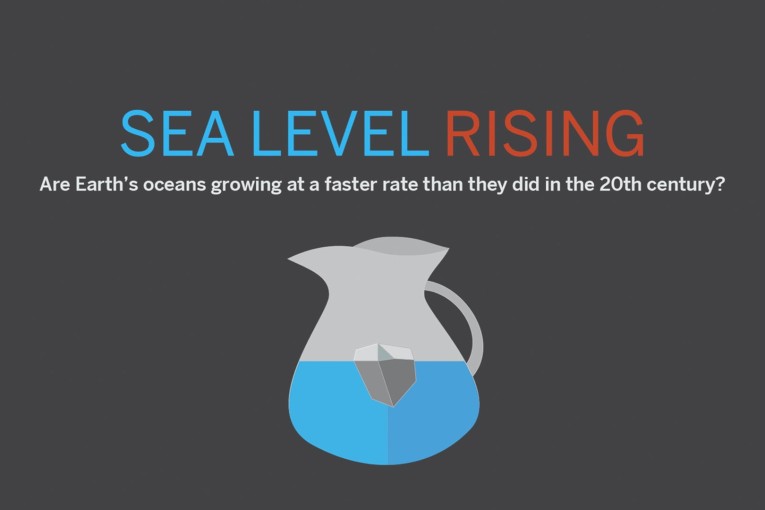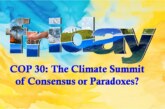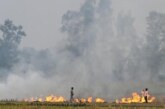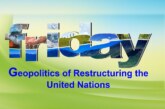
 Across the world, climate change, the loss of biodiversity, land degradation and water scarcity are growing problems that need to be urgently addressed if the world is to achieve the goals set out in the 2030 Agenda for Sustainable Development, the reports state.
Across the world, climate change, the loss of biodiversity, land degradation and water scarcity are growing problems that need to be urgently addressed if the world is to achieve the goals set out in the 2030 Agenda for Sustainable Development, the reports state.
The Global Environmental Outlook (GEO-6): Regional Assessments said that the worst impacts of climate change are projected to occur in the Pacific and South and Southeast Asia. It said focusing on the population at risk from sea level rise by 2050, seven of the 10 most vulnerable countries worldwide are in the Asia Pacific region. India tops the chart with nearly 40 million people in the country projected to be at risk from rising sea levels, followed by more than 25 million in Bangladesh, over 20 million in China and nearly 15 million in the Philippines. It said that changes in settlement patterns, urbanisation and socio-economic status in Asia have influenced observed trends in vulnerability and exposure to climate extremes.
The report said that in many coastal areas, growing urban settlements have also affected the ability of natural coastal systems to respond effectively to extreme climate events, rendering them more vulnerable. “Some countries, such as China, India and Thailand, are projected to face increased future exposure to extremes, especially in highly urbanised areas, as a result of rapid urbanisation and economic growth,” it said. It listed Mumbai and Kolkata in India, Guangzhou and Shanghai in China, Dhaka in Bangladesh, Yangon in Myanmar, Bangkok in Thailand, and Ho Chi Minh City and Hai Phong in Vietnam as projected to have the largest population exposure to coastal flooding in 2070. In 2011, six of the ten countries most vulnerable to climate change worldwide were in Asia and the Pacific.
The report said livelihoods can be impacted negatively by natural disasters, economic crises and climate change. On coastal areas highly exposed to cyclones and typhoons the poor tend to be more exposed to natural disasters because they live on hazardous land. Evidence suggests that climate change and climate variability and sea-level rise will exacerbate multi-dimensional poverty in most developing countries. By 2050, areas of storm surge zones are expected for Bangladesh, China, India, Indonesia, and the Philippines, with a combined total of over 58 million people at risk. “Many of these cities are already exposed to coastal flooding, but have limited capacity to adapt due to their fixed location,” it said.
According to UNEP report “If current trends continue and the world fails to enact solutions that improve current patterns of production and consumption, if we fail to use natural resources sustainably, then the state of the world’s environment will continue to decline. It is essential that we understand the pace of environmental change that is upon us and that we start to work with nature instead of against it to tackle the array of environmental threats that face us.”
Asia and the Pacific
Unprecedented economic growth, which has lifted millions out of poverty in Asia and the Pacific, is putting heavy pressure on ecosystems. Increasing unsustainable consumption patterns have led to worsening air pollution, water scarcity and waste generation, threatening human and environmental health. Increased demand for fossil fuels and natural resources – extensive agriculture, palm oil and rubber plantations, aquaculture and the illegal trade in wildlife – are causing environmental degradation and biodiversity loss.
Natural disasters
Last year, the Asia Pacific region continued to be the world’s most disaster prone region. About 41 per cent of all natural disasters reported over the last two decades occurred in the Asia-Pacific region, which also accounted for 91 per cent of the world’s deaths attributable to natural disasters in the last century.
The number of record-breaking rainfall events increased by 56 per cent over the 1981 – 2010 . By the 2070s the top Asian cities in terms of population exposure to coastal flooding will be Bangkok, Dhaka, Guangzhou, Kolkata, Mumbai and Shanghai, threatening hundreds of millions of people with displacement.
Deforestation
In Southeast Asia, the average area deforested annually is more than 1 million hectares, resulting in the release of hundreds of millions of tonnes of carbon dioxide every year between 2005 and 2015.
Water
The contamination of water sources by human and industrial waste, including pharmaceutical and personal care products, is a major problem in the region, the GEO-6 reports state. It is estimated that about 30 per cent of the population uses drinking water contaminated by human feces. Water-related diseases and unsafe water contribute to 1.8 million deaths annually and 24.8 million disability-adjusted life years in the region. Unsafe sanitation, disposal of untreated wastewater and runoff of agrochemicals are responsible for a rise in water-borne diseases, especially in Asia’s population-dense urban areas.
Waste
Uncontrolled dumping, which is still the main waste disposal method in the region, is also a major source of disease. In Mumbai, for example, about 12 per cent of total municipal solid waste is burned either openly on the streets or in landfills, a practice that releases black carbon, dioxins and carcinogenic furans.
Population growth, a growing middle class and urbanization have led to higher emissions and growing amounts of ill-managed waste, the report states. Rapid economic growth and intensified industrialization has also led to increasingly unhealthy, polluting and carbon-intensive lifestyles.
Growing consumption
The main driver for accelerating domestic material consumption is the expanding middle class (from 21 per cent in 1990 to 56 per cent in 2008). The size of the global middle class is projected to increase from 1.8 billion (2009) to 4.9 billion in 2030 with most of this growth coming from Asia. The OECD predicts that the middle class’s global spending will grow to $56 trillion by 2030 from $21 trillion today and that more than 80 per cent of this increase is expected to come from Asia and the Pacific.
The United Nations Environment Assembly (UNEA) is the world’s most powerful decision-making body on the environment, responsible for tackling some of the most critical issues of our time. The assembly holds the power to dramatically change the fate of the planet and improve the lives of everyone, impacting everything from health to national security, from the plastic in our oceans to the trafficking of wildlife. Thanks to UNEA, the environment is now considered one of the world’s most pressing concerns alongside other major global issues such as peace, security, finance and health.
This year, hundreds of key decision makers, businesses and representatives of intergovernmental organizations and civil society will in May gather at UNEA-2, taking place at the United Nations Environment Programme headquarters in Nairobi, for one of the first major meetings since the adoption of the 2030 Agenda for Sustainable Development and the Paris Climate Agreement. The resolutions passed at UNEA-2 will set the stage for early action on implementation of the 2030 Agenda, and drive the world towards a better future, more-just future.
Overall Recommendations
- Strengthen intergovernmental coordination at the regional and sub-regional level will improve governance issues that are of regional priority.
- Improve gathering, processing and sharing of data and information to inform decision-making.
- Enhance sustainable consumption and production to reduce environmental pressures by addressing drivers associated with manufacturing processes and consumer demand
- Harness natural capital in a way that does not damage ecosystems.
- Implement measures to reduce pollution and other environmental pressures.
- Invest in urban planning, such as through the better use of environmentally sound. infrastructure and clean transport, which can turn the urban challenge into opportunities for sustainable development.
- Governments will likely need to find innovative solutions to allow for the decoupling of economic growth and resource consumption.
- Reduce dependence on fossil fuels, and diversify energy sources.
- Greater investments are needed in environmental accounting systems to ensure external costs, and in foresight processes to identify possible future risks, opportunities and conflicts.
- Enhance international cooperation on climate, air quality and other environmental issues.
- Respond to environmental health risks.
- Build resilience to natural hazards and extreme climate events.
- Low-carbon, climate-resilient choices in infrastructure, energy and food production coupled with effective and sustainable natural resource governance are key to protecting the ecological assets that underpin a healthy society.
By Dr. Arvind Kumar



